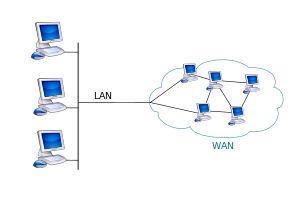Awide area network(WAN) is a telecommunications network orcomputer network that extends over a large geographical distance. Wide area networks are often established with leased telecommunication circuits.[1]
Business, education and government entities use wide area networks to relay data to staff, students, clients, buyers, and suppliers from various locations across the world. In essence, this mode of telecommunication allows a business to effectively carry out its daily function regardless of location. TheInternet may be considered a WAN.[2]
Related terms for other types of networks arepersonal area networks (PANs), local area networks (LANs), campus area networks(CANs), or metropolitan area networks(MANs) which are usually limited to a room, building, campus or specific metropolitan area respectively.
Design options
The textbook definition of a WAN is a computer network spanning regions, countries, or even the world.[3] However, in terms of the application of computernetworking protocols and concepts, it may be best to view WANs as computer networking technologies used to transmit data over long distances, and between different LANs, MANs and other localised computer networking architectures. This distinction stems from the fact that common LAN technologies operating at lower layers of the OSI model(such as the forms of Ethernet or Wi-Fi) are often designed for physically proximal networks, and thus cannot transmit data over tens, hundreds or even thousands of miles or kilometres.
WANs do not just necessarily connect physically disparate LANs. A CAN, for example, may have a localized backbone of a WAN technology, which connects different LANs within a campus. This could be to facilitate higher bandwidth applications or provide better functionality for users in the CAN.
WANs are used to connect LANs and other types of networks together so that users and computers in one location can communicate with users and computers in other locations. Many WANs are built for one particular organization and are private. Others, built byInternet service providers, provide connections from an organization's LAN to the Internet. WANs are often built usingleased lines. At each end of the leased line, arouter connects the LAN on one side with a second router within the LAN on the other. Leased lines can be very expensive. Instead of using leased lines, WANs can also be built using less costly circuit switching or packet switching methods. Network protocolsincluding TCP/IP deliver transport and addressing functions. Protocols includingPacket over SONET/SDH, Multiprotocol Label Switching (MPLS), Asynchronous Transfer Mode (ATM) and Frame Relay are often used by service providers to deliver the links that are used in WANs. X.25 was an important early WAN protocol, and is often considered to be the "grandfather" of Frame Relay as many of the underlying protocols and functions of X.25 are still in use today (with upgrades) by Frame Relay.
Academic research into wide area networks can be broken down into three areas:mathematical models, network emulation andnetwork simulation.
Connection technology
Many technologies are available for wide area network links. Examples include circuit switched telephone lines, radio wavetransmission, and optic fiber. New developments in technologies have successively increased transmission rates. In ca. 1960, a 110 bit/s (bits per second) line was normal on the edge of the WAN, while core links of 56 kbit/s to 64 kbit/s were considered fast. As of 2014, households are connected to the Internet with Dial-Up, ADSL,Cable, Wimax, 4G or fiber. The speeds that people can currently use range from 28.8 Kilobits per second through a 28K modemover a telephone connection to speeds as high as 100 Gigabits per second over an Ethernet 100GBaseY connection.
AT&T plans to start conducting trials in the year 2017 for businesses to use 400 Gigabit Ethernet.[4] Researchers Robert Maher, Alex Alvarado, Domaniç Lavery & Polina Bayvel of University College London were able to increase networking speeds to 1.125 Terabits per second.[5] Christos Santis, graduate student Scott Steger, Amnon Yariv, Martin and Eileen Summerfield developed a new laser that quadruples transfer speeds over fiber optic cabling.[6] If these two technologies were combined, then a transfer speed of up to 4.5 Terabits per second could potentially be achieved, although it is unlikely that this will be commercially implemented in the near future.
List of WAN types
See also
- Metropolitan area network (MAN)
- Storage area network (SAN)
- Internet area network (IAN)
- ISDN
- Packet switching
- Cell switching
- Label Switching
- X.25
- Frame Relay
- Asynchronous Transfer Mode
- SONET/SDH
- Wireless wide area network
- Low Power Wide Area Network (LPWAN)
- Wide area file services
- Wide area application services

Comments
Post a Comment